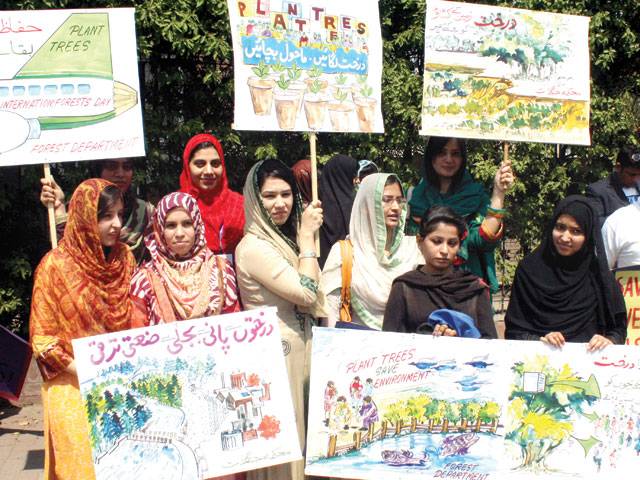LAHORE - The World Wide Fund for Nature-Pakistan (WWF-Pakistan) has started vaccination of livestock in villages upside Bela Forest, inner most part of Taunsa Barrage Wildlife Sanctuary, Kot Addu, to check transmission of diseases to critically-endangered Axis porcinus, commonly known as hog deer.
People in villages upside the Bela forest, mostly from Lumarwala, bring domestic animals for grazing, posing threat to natural habitat and disease transmission to wild animals, hog deer and wild boar.
“People bring about 2,000 domestic animals for grazing in grassy field of Bela forest daily. The number reduces to 500-800 during flood season. We are vaccinating domestic animals upside Bela forest for community service and checking disease transmission to wild animals. So far about 2500 domestic animals have been vaccinated and provided de-worming doses with the technical assistance of Livestock Department”, said Site Coordinator of WWF-Pakistan Umer Waqas. He added grazing of domestic animals in the Bela forest would be banned after creating awareness among people in upside villages and providing them alternative means. He said that frequent grazing of domestic animals has already resulted into up to 15 cows going feral.
He said that the WWF-Pakistan was working in close liaison with local community to gradually reduce dependence of locals on the Bela forest.
"It is challenging working with communities with limited resources. WWF-Pakistan is taking every possible measure to conserve natural resources by empowering local communities to reduce their dependence on them", he said.
WWF-Pakistan is also helping create awareness among the local community by promoting the establishment of Community Based Organizations (CBOs) in the area. In order to reduce their dependence on natural resources, WWF-Pakistan has also provided local communities with bio-gas plants to reduce their dependence on forests for fuel wood. Three villages in the vicinity of TBWS have been provided more than 800 fuel-efficient mud stoves which consume less wood.
In order to secure support, WWF-Pakistan has also provided 30 units of domestic livestock to the local communities. Each unit includes two cows, two goats and five hens. Thousands of fruit saplings of various fruits have also been provided to the communities free of cost so that they can earn extra income. “People from nearby villages believe that there are 300-350 hog deer in Bela forest. According to WWF-Pakistan estimate, the population of hog deer is ranging from 100 to 150. The number of wild bore exceeds 2000”, Umer Waqas said, adding, there was no competition among hog deer and wild bore as there feed and feeding time was different.
“Wild boar come out in search of food before sunset and go in hiding at midnight. Grazing period for shy hog deer is from midnight to before sunrise. Hog deer graze budding grass and leaves and these are not required to wild boar. Moreover, wild boar don’t not pose threat to life of hog deer and as such both can co-exist in natural habitat”, he said.
Bela Forest, covering 70,00 acres, is inner part of 16,225 acres Taunsa Barrage Wildlife Sanctuary. Bela is densely packed with Typha spp., Tamarix spp. and Saccharum spp. that provide an ideal habitat for some animals and bird species including critically endangered hog deer. The sanctuary area prohibits all sorts of anthropogenic activities such as residing, cultivation of land, destroying vegetation, hunting and killing of wild animals, polluting water and introduction of any exotic plant or animal species.
Thursday, April 18, 2024
For dear deer!

Caption: For dear deer!
Jailed Myanmar leader Suu Kyi moved to house arrest
April 18, 2024
Venezuela shuts Ecuador diplomatic missions over raid
April 18, 2024
Russian missile strike in northern Ukraine kills 16
April 18, 2024
Political Reconciliation
April 16, 2024
Pricing Pressures
April 16, 2024
Western Hypocrisy
April 16, 2024
Policing Reforms
April 15, 2024
Storm Safety
April 15, 2024
Workforce inequality
April 17, 2024
New partnerships
April 17, 2024
Shikarpur crisis
April 17, 2024
Peace quest
April 17, 2024
Democratic harmony
April 16, 2024
ePaper - Nawaiwaqt
Advertisement
Nawaiwaqt Group | Copyright © 2024





